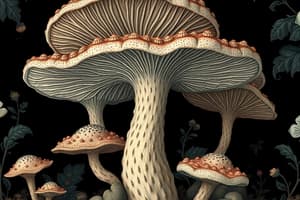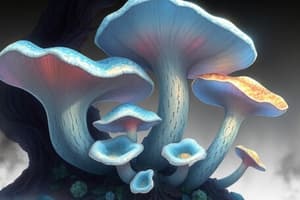Podcast
Questions and Answers
What role do fungi play in bioremediation?
What role do fungi play in bioremediation?
Fungi help in the degradation of pollutants, thus facilitating the cleaning of contaminated environments.
How do fungi contribute to food production?
How do fungi contribute to food production?
Fungi, especially yeast, are essential in the production of bread and beer through fermentation.
What significance do fungi have in medicine?
What significance do fungi have in medicine?
Fungi produce important antibiotics and other medicinal compounds, playing a critical role in healthcare.
What are some potential future research directions in mycology?
What are some potential future research directions in mycology?
What are mycoses, and why are antifungal therapies important?
What are mycoses, and why are antifungal therapies important?
What distinguishes fungi from plants and animals?
What distinguishes fungi from plants and animals?
Explain the structure and function of hyphae in fungi.
Explain the structure and function of hyphae in fungi.
What are the primary methods of fungal reproduction?
What are the primary methods of fungal reproduction?
How is modern classification of fungi different from traditional methods?
How is modern classification of fungi different from traditional methods?
Describe the role of fungi in nutrient cycling within ecosystems.
Describe the role of fungi in nutrient cycling within ecosystems.
What is a mycorrhizal relationship, and why is it important?
What is a mycorrhizal relationship, and why is it important?
Identify two types of fungi based on their morphological forms.
Identify two types of fungi based on their morphological forms.
How do parasitic fungi obtain their nutrients?
How do parasitic fungi obtain their nutrients?
Flashcards
Fungi and Bioremediation
Fungi and Bioremediation
Fungi can break down harmful substances in the environment.
Fungi and Plant Diseases
Fungi and Plant Diseases
Some fungi cause diseases in plants.
Fungi in Food Production
Fungi in Food Production
Fungi are essential for making bread, beer, and many other foods.
Fungi and Industrial Enzymes
Fungi and Industrial Enzymes
Signup and view all the flashcards
Fungal Infections (Mycoses)
Fungal Infections (Mycoses)
Signup and view all the flashcards
What is Mycology?
What is Mycology?
Signup and view all the flashcards
What are fungi?
What are fungi?
Signup and view all the flashcards
What is the fungal cell wall made of?
What is the fungal cell wall made of?
Signup and view all the flashcards
What are hyphae?
What are hyphae?
Signup and view all the flashcards
What is mycelium?
What is mycelium?
Signup and view all the flashcards
What are saprophytes?
What are saprophytes?
Signup and view all the flashcards
What are parasites?
What are parasites?
Signup and view all the flashcards
What are mycorrhizae?
What are mycorrhizae?
Signup and view all the flashcards
Study Notes
Introduction to Mycology
- Mycology is the study of fungi.
- Fungi are eukaryotic organisms, distinct from plants, animals, and bacteria.
- Fungi are essential in ecosystems for decomposition, nutrient cycling, and symbiotic plant relationships.
- Fungi impact humans through medicinal, culinary, and industrial applications.
Structure and Morphology of Fungi
- Fungi have diverse forms: yeasts (single-celled), molds (filamentous), and mushrooms (complex).
- Fungi have a unique cell wall primarily composed of chitin.
- Hyphae are thread-like structures that form a network called mycelium.
- Mycelium facilitates nutrient absorption.
- Fungi reproduce sexually or asexually through various spores.
- Spore types include conidia, sporangiospores, and ascospores, differing by species and reproductive cycle.
- Fungal fruiting bodies, like mushrooms, produce spores for dispersal.
Classification of Fungi
- Traditional fungal classification uses morphology, reproduction, and biochemistry.
- Modern methods increasingly use DNA sequencing.
- Major fungal groups include chytrids, zygomycetes, glomeromycetes, ascomycetes, and basidiomycetes.
- These groups differ in spore structures and sexual reproduction methods.
Fungal Nutrition and Metabolism
- Fungi are heterotrophic, absorbing nutrients.
- Secretion of enzymes breaks down complex organic matter for absorption.
- Saprophytic fungi decompose dead matter.
- Parasitic fungi extract nutrients from living hosts.
- Mutualistic relationships, like mycorrhizae (fungi and plant roots), exist.
- Fungi have metabolic pathways for diverse sources of carbon and nitrogen.
Importance of Fungi in Ecosystems
- Fungi are vital decomposers, releasing nutrients.
- Mycorrhizae enhance nutrient uptake and plant growth.
- Fungi participate in pollution degradation, aiding bioremediation.
- Some fungi cause plant diseases.
Economic and Medical Significance
- Fungi are economically important in food production (e.g., yeast in bread).
- Fungi produce valuable enzymes for industry.
- Many fungi are edible, while some are poisonous.
- Some fungi yield antibiotics and other medicines.
- Fungal infections (mycoses) affect humans and animals.
- Antifungal treatments are vital for managing mycoses.
Research and Future Directions
- Mycology research advances knowledge of fungal diversity, evolution, and interactions.
- New fungal species and roles are constantly discovered.
- Future research focuses on fungal applications in bioremediation, biofuels, and biotechnology.
- Genomics and molecular biology improve understanding of fungi.
Studying That Suits You
Use AI to generate personalized quizzes and flashcards to suit your learning preferences.




